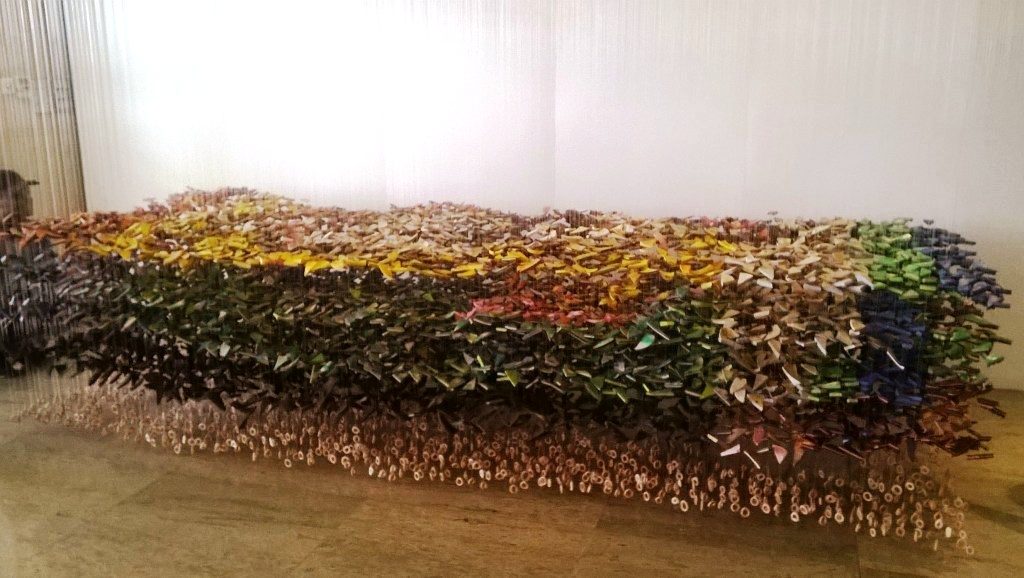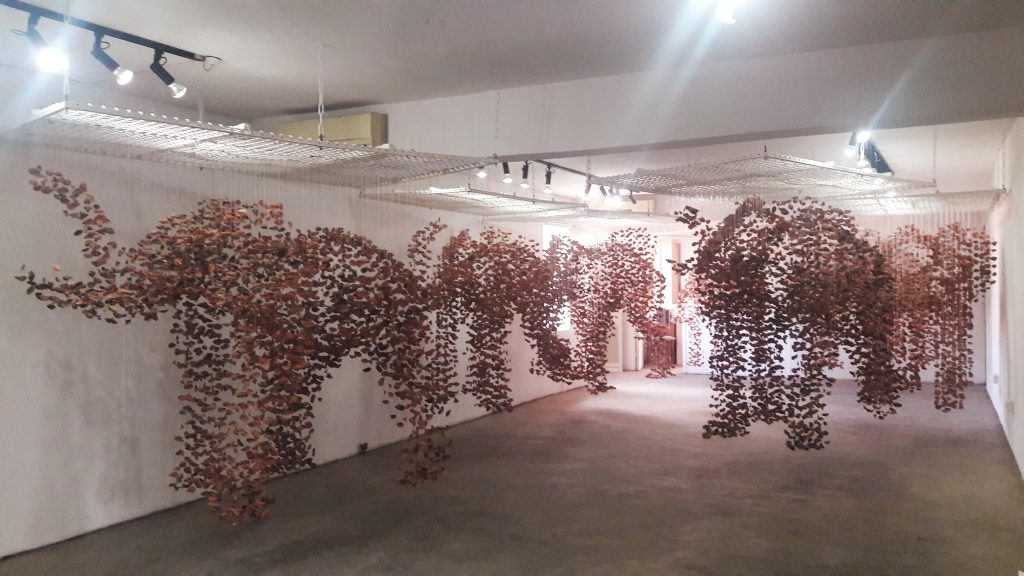
For many Lagos residents, their first encounter with Ngozi Omeje’s work was at the premiere edition of ART X Lagos, in 2016. Her mixed media installation piece, In My Garden There Are Many Colours, was one of the curated projects at the fair. The installation consisted of many strings suspending. Towards their ends, ceramic clay units and cut-up pieces of flip-flops of various colours came together like a colourful garden bed.
Not only driven by aesthetic appeal, Omeje’s work also strives to make social commentary. Her personal experiences have always informed the themes she explores in her work. The constraint faced as a girl-child informs most of the ideas and the direction of her thoughts. Channelling Frida Kahlo who painted the reality she knew, Omeje is spurred by the challenges she faces daily as a woman. The installation at ART X, for instance, explored womanhood as a garden of dreams and hopes which oftentimes remain unfulfilled. The piece took about 8 weeks to create, with Omeje salvaging used flip-flops from her surroundings. “This is symbolic for me” she shared in an interview, “it is like gathering the imprints of people unknown. These pieces serve as documentaries of (their) anonymous presence which I represent through my own experiences.” The audience was intrigued by the work because of the flexibility of immersing in and engaging with the installation in a way that another medium would probably not have provided.
A look into her background reveals that she was born into an art-oriented family, although not with any formal art training. Her father did a lot of metal constructions and her mother was a tailor. The eldest son of the family is a graphic artist. This natural artistic inclination in the family formed her background in art.
In 2001, she enrolled to study Fine and Applied Arts at the University of Nigeria, Nsukka, and continued in the same school to gain a master’s degree in Fine Arts, with a specialisation in Ceramics. Her foray into mixed media works began during her MFA. Her project focused on the integration of ceramic forms, pushing her to introduce materials beyond clay into her work. Her installations have since then not comprised entirely of clay. The early mixed-media installations were inspired by the elements of fishing, incorporating the idea of the bait, line and floater. It has, however, expanded to other forms of expression. To introduce colour to the artworks without necessarily painting them, she settled for the use of coloured flip-flops which are intricately arranged to produce an easy visual connection. The ideas behind the form inspire her assemblage of the materials and her use of strings has evolved to be more purposeful. Utilizing strings to give life to her works, she continued to explore, develop and experiment with large forms, as seen in the works Imagine Jonah (2009), and Think Tea, Think Cup (2010) – which she created during a one-month residency at the Sevshoon Art Centre, Seattle, USA. With the incorporation of lighter materials like flip-flops, her works became more durable and easier to transport.
Through the years of her practice, Omeje has evolved from producing utilitarian ceramic art to conceptual ceramic installations – which she has mastered – and continues to challenge herself by rendering in larger complex symmetry as seen in her last exhibition, Connecting Deep, at the Centre for Contemporary Art.

At the exhibition space of the Centre for Contemporary Art, Lagos, which was transformed to resemble a park for Connecting Deep, eight sculptural elephants made from globular clay units, were suspended in the air. One of the eight elephants stood out imposingly from the rest – it was the largest in the room. The others varied in sizes, fixed in different gestural positions toward that large one. Beyond the sheer size, the installation was magnificent and compelling. Working with intricate precision, Omeje combined moulding, tying, wrapping, and hanging to configure the striking clay forms. The installation uses the elephant as a symbol of gentleness and greatness. In a written statement about the exhibition, she stated, “The elephant is for me, a figuration of my father whose accomplishments and personal attributes such as care, love and strength of will, are gigantic like the elephant and also earned him the title of ‘Oruimenyi’ (the strength of an elephant)”.
Among the Igbo people – Omeje’s ethnic tribe in Nigeria – the elephant is a revered animal and has been a recurrent motif in their culture in times past, attributed to men in praise and respect for their strength, wisdom and valour. This symbolism dates as far back as the 10th century, and is still present in their chieftaincy titles, idiomatic expressions and masquerades festivals. The associate curator of the exhibition, Iheanyi Onwuegbucha, explained the elephant symbolism in Igbo culture, making reference to ‘Odu Enyi’ (elephant tusk) held by rich, powerful men, and in their absence, is used to represent their authority. Titles such as ‘Nnabuenyi’ meaning ‘Father is Elephant’, is given in very high honour to one’s father.
Omeje’s work reflects a similarity in style to Bright Ugochukwu Eke, also a graduate of the Nsukka Art School, who works with discarded and waste materials in complex symmetrical installations that allows the audience to immerse in and engage with his works. However, Omeje draws inspiration for her works from clay. Clay provides for her a certain calmness she does not readily experience with other materials. “The malleability of clay,” she said, “allows room for mistakes and corrections that are most suitable for me as an artist.”
The lines separating the roles and scope of a ceramic artist, a potter, and a clay artist could appear to be blurry, but Omeje clarifies this, stating that there are indeed distinctions between these three specialities. “The ceramic artist explores a broader scope than the potter. The potter is basically concerned with utilitarian wares while the ceramic artist involves designs and technology. The clay artist is simply any artist from any genre of art that has made clay his/her medium.”
She occasionally considers creating ceramic art for interior finishing and placement but is yet to explore that interest.
Ceramic art is not the only art medium that lures her interest, as she said, “I have always loved painting. Although I did not specialize in it, I have found a way of incorporating it into my installation, thereby, achieving what could be called painting by suspension or suspended painting”.
Omeje has won first prize in the Life in My City Art Competition twice, in 2011 and 2014 respectively, and were acquired by the organization. She also won the prize for Outstanding Concept in the National Art Competition in 2015. For an award-winning artist, one would expect more visibility for the artist for exploring an uncommon medium such as clay art, yet, her work is unfamiliar to many art enthusiasts. The reason is not far-fetched. Resident in Nsukka with only so many art events, mostly academic-driven ones, she is easily cut off from the Lagos art scene which is arguably the hub for Nigerian art and culture.





Do give name of the AUTHOR of Essay.
Ngozi Omeje spent a week with the students at Banana Island School interacting with the children and working with clay during the School Art Week. The ensuing art work, produced with the children (some as young as 18 months), ‘garden of dreams’ is truly amazing. She is a really undervalued artist and yes, were she in Lagos, she would be definitely better known and much more celebrated.